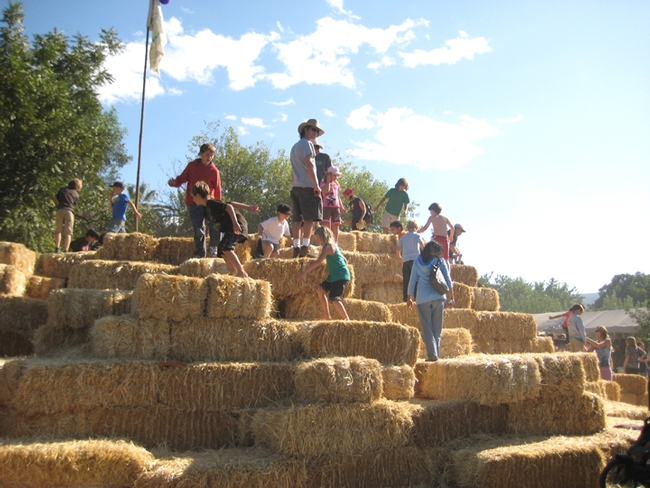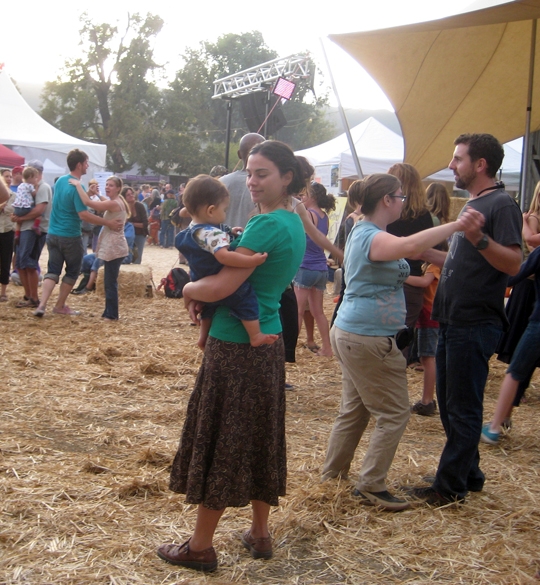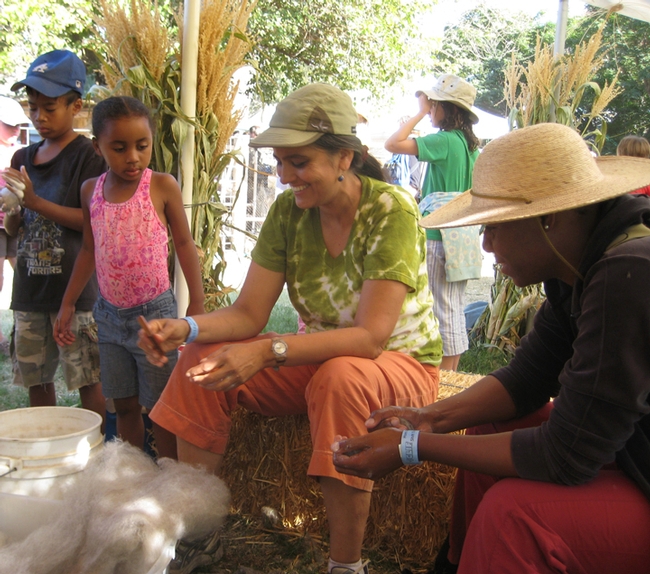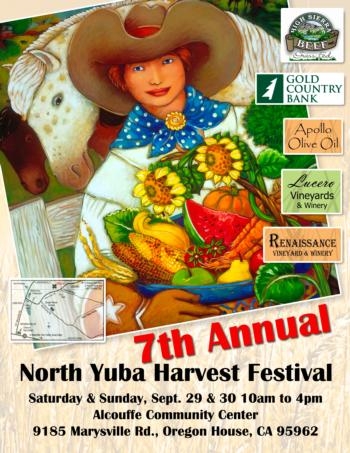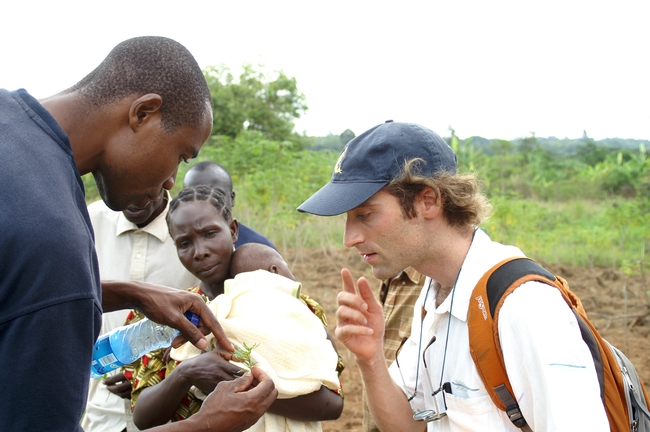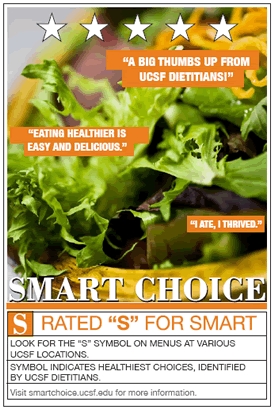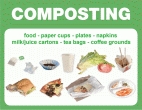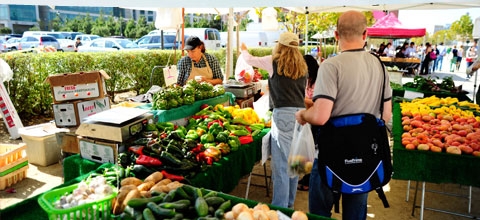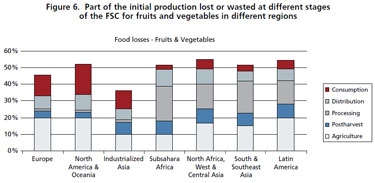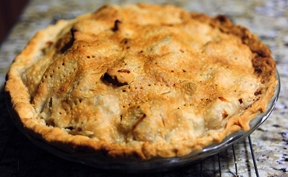UC Food Blog
Turn off your computer, put down your hoe
Feel that chill in the morning air? Autumn's here, school's starting, and soon we'll be bustling about, wearing sweaters, cleaning rain gutters and raking leaves. But first, according to many traditions, it's time to take a break and celebrate the harvest with local farmers.
Many cultures throughout the Northern Hemisphere have long traditions of harvest festivals held around the time of the main harvest in autumn. Most harvest festivals feature feasting, music, romance, dancing and freedom from work, sometimes lasting for days.
In Asia, the Moon Festival is a popular harvest festival celebrated in September or early October by Chinese and Vietnamese people. The Jewish holiday Sukkot, celebrated for seven days in late September to late October, commemorates the agricultural "Feast of Ingathering."
In Britain, harvest festivals have been held since ancient times at the time of the "Harvest Moon", which is the full moon that occurs closest to the autumn equinox (about Sept. 22). In two years out of three, the Harvest Moon comes in September, but in some years it occurs in October. The early English settlers' first American Thanksgiving feast celebrated their first harvest in 1621, sometime between September 21 and November 9, most likely in early October.
A century ago, more than half of all Americans were engaged in agriculture. These days, with less than 2 percent of the population involved in farming or ranching, most of us are pretty removed from celebrating the harvest. However, California farmers offer us a lot of chances this Harvest Moon to join the celebrations and learn about their farms. The University of California Division of Agriculture and Natural Resources (ANR) hosts a directory and event calendar of California agritourism, that is, farms and ranches open to the public for enjoyment and education to help urban and suburban people find these opportunities.
Many families keep the autumn harvest tradition alive by visiting a pumpkin patch to select a pumpkin from the field and trying to navigate a corn maze. Others enjoy apple orchards with picnics, pies and craft fairs. My family has a favorite harvest tradition of our own. My wife and I volunteer every year at the Hoes Down Harvest Festival held the first weekend each October at Full Belly Farm, an organic farm in Guinda, in the Capay Valley of Yolo County. We join hundreds of volunteers who help make Full Belly a temporary home for several thousand festival attendees each year. People of all ages, mostly city and suburban families from the Bay Area and Sacramento area, come out to enjoy rural life on an organic family farm.
This year will be the 25th annual Hoes Down Festival. It is organized by the Ecological Farming Association, a group of organic farmers who have been leaders in developing California organic farming over the last 30 years, and who also put on the EcoFarm Conference in Pacific Grove every January. The festival proceeds benefit local organizations including Future Farmers of America (FFA), the local volunteer fire department, and the Community Alliance with Family Farmers (CAFF), and also help support the EcoFarm Festival. Full Belly Farm, where the festival is held, is a magical 300 or so acres of some of the best examples of diversified organic farming around, integrating vegetables, fruit and nut crops with poultry, sheep, goats and even a few cows. If you do go to the Hoes Down Festival, be sure to make time for one of the walking tours of the farm led by one of the four farm owners, and learn a bit about hedgerows, crop rotation and how sheep can be part of growing healthy fruits and vegetables.
This two-day celebration (Sunday is a big farm breakfast and longer workshops) has music and other entertainment all day Saturday on several stages (one for children), hay rides around the farm, good food, workshops, nature walks, games, baby animals to pet, a farmers' market, craft fair, dancing, and lots to see and learn. You can watch sheep get sheered, join in a Contra Dance, learn to make herbal tinctures, take a dip in the river and make a dried flower wreath, or just sit back, drink a beer and listen to the music. Children can grind wheat, make a corn-husk doll, learn to spin wool, climb on an exciting hay-bale mountain full of secret passages, listen to stories inside a tipi and much more. You can camp overnight in the walnut orchard after dancing under the stars. The weekend is an immersion in another world - the world of harvest festival.
When: Saturday, October 6 & Sunday, October 7, 2012
Where: Full Belly Farm, County Road 43 Guinda, CA 95637
Admission prices: Adults: $20 each when purchased online; $25 when purchased at the gate, Children (2-12): $5 each anytime! Under 2: Free.
Saturday night camping: $25 per car
More info: http://www.hoesdown.org/
UC ANR's online agritourism directory, www.calagtour.org, lists many chances to celebrate the harvest season with farmers. Here are a few:
-
North Yuba Harvest Festival in Oregon House
The North Yuba Harvest Festival will feature tasting of gold-medal local wines and olive oils, food vendors, live entertainment, arts, crafts, fresh produce, children´s activities and much more. This year it will be a full TWO DAYS of festival fun, from 10 a.m. to 4 p.m. both Saturday and Sunday.
When: Saturday Sept. 29 & Sunday Sept. 30
Where: 9185 Marysville Road, Oregon House, CA 95962
Free entry, with $5 suggested parking donation.
Wine tasing and souvenir glass $10
Information: 530-692-2476 or www.alcouffecenter.org or www.northyubagrown.org -
Sierra Oro Farm Trail Passport Weekend
From 10 am to 5 pm Saturday and Sunday, travel the scenic agricultural trails of Butte County, sampling local fare including artisan olive oil, grass-fed meats, specialty nuts, award-winning wines and more. This annual agri-tourism adventure showcases 28 participating wineries and specialty farms throughout Butte County and provides trail goers with a once-a-year chance to savor the amazing farm-fresh bounty produced locally.
When: Saturday October 6 and Sunday October 7, 10 a.m. - 5 p.m.
Where: Butte County (Oroville, Chico, Paradise regions)
Cost & registration: Passports cost $25 per person and include a 2012 map and free commemorative wine glass. Based on availability, Passports will cost $30 per person the day of the event.Click here to order your 2012 Passports online now.
For more information, please visit Sierraoro.org, email info@sierraoro.org or call 530-891-5556
- Fall Harvest Festival at the UC Santa Cruz Farm
Join the Center for Agroecology & Sustainable Food Systems on the UC Santa Cruz Farm for a full slate of music, food, tours, kids’ activities, cooking demos, gardening workshops, an apple pie baking contest, apple tasting, and much more!
When: September 30, 11 a.m. to 5 p.m.
Where: UC Santa Cruz Farm
Cost:The festival is free for UCSC students, Friends of the Farm and Garden members, and kids 12 and under; $5 general admission.
For more information: contact casfs@ucsc.edu, 831.459-3240, or see http://casfs.ucsc.edu. Directions are available on the website.
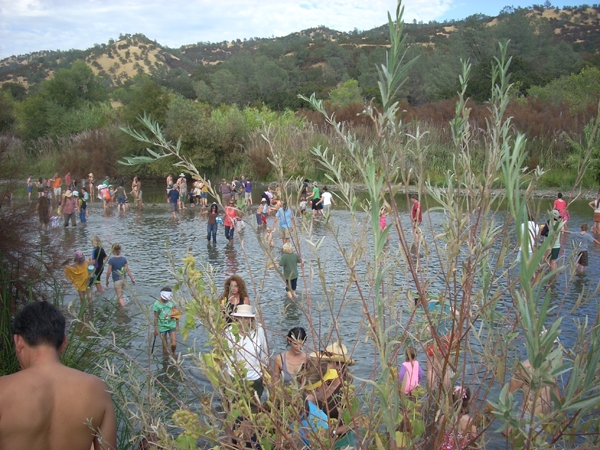
HoesDown2010river
Grad students head abroad to work with farmers
You’ve probably heard it millions of times in your lifetime, but it bears repeating: Not everyone has enough, good food to eat.
To that end, the Horticulture Collaborative Research Support Program at UC Davis builds global partnerships for fruit and vegetable research to improve livelihoods in developing countries.
Through Horticulture CRSP’s Trellis Fund, these students have been matched with organizations in Nepal, Uganda, Rwanda, Kenya, Tanzania, Honduras and Nicaragua to provide their agricultural expertise in assisting the organizations' projects with smallholder farmers.
Besides supporting local farmers in developing countries, the projects will also potentially infect students with an interest in international agricultural issues.
“With the Trellis Fund, our goal is to engage young people in an international experience — a chance to partner with a small organization working with real people with real needs and apply what they know about science,” said Beth Mitcham, UC Cooperative Extension specialist in the Plant Sciences Department at UC Davis and director of Horticulture CRSP. “For a small investment, we’re creating lasting relationships and perhaps changing the career path of a young person.”
Read our full press release for more details, or find out who is going where on our Trellis Fund page.
UC healthcare supports healthier menus and zero waste
Can I introduce the unappetizing topic of hospital food? Hospitals are notorious for not practicing what they preach in their own food service operations. Their food vendors provided fruits and vegetables that were overcooked, over-sugared, over-salted and ready-to-eat. By “leaving the cooking to them,” vendors made cafeterias more profitable by eliminating labor-intensive, freshly prepared meals. Kitchens replaced skilled cooks with untrained staff who rarely needed paring knives except for opening, reheating and disposing of packaging. Fortunately, sustainability goals are helping hospitals (like school cafeterias) undergo menu reform to make more local, fresh options available for their staff, visitors and patients.
Kaiser Permanente, a leader in the reform movement since 2003, has established 50 farmers’ markets at their facilities. A recent survey published in Journal of Agriculture, Food Systems, and Community Development (subscription required) found that 74 percent of patrons surveyed at Kaiser Permanente markets consume more fruits and vegetables as a result of shopping there, and 71 percent indicated that they were eating a greater variety of fruits and vegetables.
Gail Lee, UCSF’s Sustainability Manager, credits UC Office of the President for inspiring each campus and medical center food service operation to achieve their goal of procuring 20 percent sustainable food products by the year 2020. UCSF started weekly farmers’ markets at the Mission Bay campus from April to November and at the Parnassus campus year round. UCSF is working towards achieving zero food waste by 2020, having implemented post customer compost/recycling programs at 100 percent of their food service locations last year.
Procurement practices — yogurts served to patient and visitors are now local and organic — play a major role in transforming menus. As project manager for an EPA-funded project award, Gail is partnering with UC Berkeley to identify systematic methods that will encourage certifiable, green procurement. She launched their green office and green lab certification and produced an entertaining sustainability video that created a buzz at all four SF campuses.I am proud to be joining Gail’s team to help implement the UC goals. UC Davis was recently declared a “cool school,” but UCSF is well on the way to becoming a nationally recognized “cool hospital” and research campus.
This is good news for those of us who prefer fresh fruit salad to canned fruit cocktail, in spite of the fact that fruit cocktail was a UC Berkeley invention. Professor William Cruess was looking for a way to use the small, wasted bits left over after canning fruit. In his defense, I have to remind myself that the alternative for many parts of the nation in that decade was no fruit at all. He saw fruit spoil in the orchards because what was true then is still true today — California produces much more fruit than locals can possibly eat. Let’s not forget to eat our share of the local bounty.
It's just a waste, II
A year ago, a co-worker wrote a post on this blog entitled “It’s just a waste.” The sad facts of food waste are something we pay attention to since we work for the UC Postharvest Technology Center. A key component of our Center’s mission is to “reduce postharvest losses.” This topic also hits close to home on a personal level since I have always struggled with using up produce before it spoils. I go shopping about once a week, and tend to purchase just a bit more produce than what we will actually eat – in the hopes that one of us will suddenly adopt healthier eating habits by increasing our intake of fresh produce. I place the produce in my fruit ripening bowl, on the counter, or in the fridge, according to the recommendations on my handy produce storage chart. But nearly every week something goes awry, usually with my schedule, and I end up not serving the delicious produce-based meals I had planned, or I forget to pack my lunch, and oops, the negative effects of delayed consumption hit my produce.
The numbers show I’m not alone in this struggle, since research reports that nearly 30 percent of all produce losses in the United States happen at the consumer level. I was surprised to learn that today the average American consumer wastes nearly 50 percent more food than we did in the 1970s. (Link to the August 2012 Natural Resources Defense Council Report.) In the Food & Agriculture Organization of the United Nation's chart you can see that consumers from every other region around the world do significantly better than we in using their produce.
I want to do better, too! I hereby resolve to try harder to stick with my menu plan, pay closer attention to produce on the counter and the fridge (sometimes known affectionately in the produce industry as the “black hole”), and I will try very hard to be more creative in my use or preservation of quickly ripening produce.
My single biggest challenge is bananas. I try to buy a smaller hand of 5 to 6 bananas with some green tint left. They go on my banana hook in a cooler corner of my kitchen. At least half the weeks of the year those bananas have black spots within 3 to 4 days, and by day 5 there are usually 2 to 3 bananas left that are no longer appealing to my family. So almost half the bananas I buy usually don’t get eaten. I know, I know, “buy a smaller hand of bananas,” you say. That’s easier said than done, at least at the markets in which I shop.
Thankfully there are many cooks out there willing to share their recipes for creative ways to use up an over-supply of bananas. Below is a starting list of ideas that I’ll be drawing from as I make an effort to reduce produce waste, and especially banana waste, in our home.
- Slice into 1-inch chunks, freeze in a single layer on a wax paper covered cookie sheet. Transfer into a zip-bag and return to the freezer to use as needed for fruit smoothies or other cooking projects
- Banana bread or banana muffins
- Homemade banana ice cream
- Banana layer cake with cream cheese frosting
- Slice lengthwise, sauté in butter and ¼ tsp. rum flavoring until golden brown, and serve on ice cream
- Banana crunch cookies
- Make banana pancakes, add chocolate chips if desired (here’s a link to a pancake recipe called “Chunky Monkey” my son-in-law likes to make)
- Peel, insert a lollipop or popsicle stick and freeze. Eat as is, or dip in melted chocolate.
- Banana drop cookies
- Slice, dip in fresh lemon juice, and dry in a dehydrator
- Make a warm spiced banana topping that’s great on ice cream or gingerbread
- Banana oatmeal bar cookies
- Banana pudding
- Fruit Skewers
- Bananas Foster
- Banana Daiquiri
- Tropical banana bar cookies with raisins, pecans and coconut
- Banana cream pie
- Peanut butter, banana and rum bar cookies
- Trifle
- Burrito Bananas Foster
- Fruit Salad
- Banana crepes
- Dessert Pizza
- Banana Bundt cake with caramel frosting
- Fruit salsa, served with cinnamon tortilla chips
- Banana split
- Strawberry-banana parfait with yogurt and granola
Cherish the Gravenstein
If an apple a day keeps the doctor away, what does a Gravenstein apple pie do?
It causes a stampede to the dining room table, that's what it does. Expect to see chairs overturning, plates flying and forks spinning.
That's because Gravensteins make the best pies. As any apple pie aficionado will tell you: the best pies are the "G" pies: Gravenstein (first) and Granny Smith (second).
The Gravenstein apple reigned as the preferred apple on our family farm in western Washington. We found the sweet-tart apple "perfect" for eating right off the tree, or made into pies, applesauce and apple cider. The cows liked them, too. A gentle nudge on the tree, and - eureka! - apples would magically fall to the ground. Talk about happy cows!
This heirloom apple also reigns supreme in Sonoma County. Just ask the Gravenstein apple farmers, area residents, restaurants and the tourists who line up to buy a bag or two.
That's because of its flavor, its propensity for being in the right place (pie) at the right time, and its short season make it even more treasured. Plus, this is an apple with an aroma. The delightful fragrance will permeate your kitchen.
It's a short, squatty looking apple, streaked with red. Sometimes Nature's paintbrush turns the thin streaks into thick bands. And the stems are short - so short and so susceptible to falling from the tree that, "growers estimate they lose 40 percent of their apples even before they are ripe," wrote Carolyn Jung of The Day newspaper, New London, Conn., in her interview with Paul Vossen, UC Cooperative Extension advisor in Sonoma and Marin counties, for a Sept. 8, 1999, article.
First described in 1797, the Gravenstein originates from Denmark, where it's known as "Gråsten." It took a couple of centuries to do it, but in 2005, Denmark declared it the "national apple."
How did it get to Sonoma County? Russian trappers first planted it there in 1811. The good citizens of Sonoma so liked the apple that they named a major artery the "Gravenstein Highway." Over the last six decades, however, "Sonoma County's Gravenstein orchards have declined by almost 7,000 acres and are currently down to 960 acres," according to an article on the Slow Food USA website.
Why? Farmers find it more profitable to grow grapes.
Also, it's not an easy apple to market. It's an early variety with a very short season, usually during a few weeks in August. Blink and it's gone.
And, it's an apple you won't find in your local produce section, tucked among the Red Delicious, Galas, Fujis, Pink Ladies and Granny Smiths.
"They don't travel well, and they don't last long (short season)," says Daniel Sumner, professor in the Department of Agricultural and Resource Economics at UC Davis and director of the UC Agricultural Issues Center. "To consumers, this is the kiss of death."
Enter the Slow Food movement. To help preserve the heirloom apple, the Russian River Slow Food group contacted area restaurants and asked that it be featured in their desserts. Getting into the preserve-the-Gravenstein act, the FruitGuys, a company that ships organic fruit to customers, donated 17 percent of this year's proceeds back to the Gravenstien apple farmers.
Every little bit helps.
In the meantime, Sebastopol continues to celebrate its annual Gravenstein Fair; this year the event took place Aug. 11-12.
In search of Gravensteins, we drove to Sebastopol on Sunday, Aug. 19, just as the season was about to end. "Ours will be gone in a couple of days," a farmer told us.
"Which apple makes the best pie?" we asked. "Granny Smiths or Gravensteins?
"Gravensteins," the farmer said. "Hands down."
We agree.
Here's our family recipe for Gravenstein apple pie. We favor using brown sugar instead of granulated white sugar. And we mix the brown sugar with cinnamon and nutmeg.
Crust for 9.5-inch pie
2 cups flour
1/2 teaspoon baking powder
2/3 cup butter-flavored Crisco, chilled
3/4 teaspoon salt
6 tablespoons water, cold
Sift flour, baking powder and salt. Mix in Crisco until the dough pieces are pea-sized. Add cold water as needed, 6 tablespoons or more, and form into a ball. Roll out dough into a circular shape and invert on pie pan.
Filling for 9.5-inch pie
8 cups of apples, peeled, cored and sliced
1 teaspoon cinnamon
1/2 teaspoon nutmeg
3/4 cup loosely packed brown sugar
1-1/2 tablespoons of butter
Preheat oven to 425 degrees. Gently mix together (with fork) brown sugar, cinnamon and nutmeg and then mix lightly through the apples. Before pouring the mixture into the pie pan, sprinkle a little cinnamon (less than 1/4 teaspoon) on the lower crust. Dot the heaping apple mixture with thin slices of butter. Place top crust on pie. Slit with sharp knife in several places and poke with prongs of fork. Sprinkle a dash of nutmeg on the crust. Line the edge with 1/2-inch strip of aluminum foil to prevent excessive browning. Bake at 425 degrees about 50 minutes or until the crust is lightly browned and the apples are cooked through. Test with fork.
Warning: the aroma of this pie will attract all the neighbors, their families, their friends and their friends' friends.
No wonder Luther Burbank said that “if the Gravenstein could be had throughout the year, no other apple need be grown.”
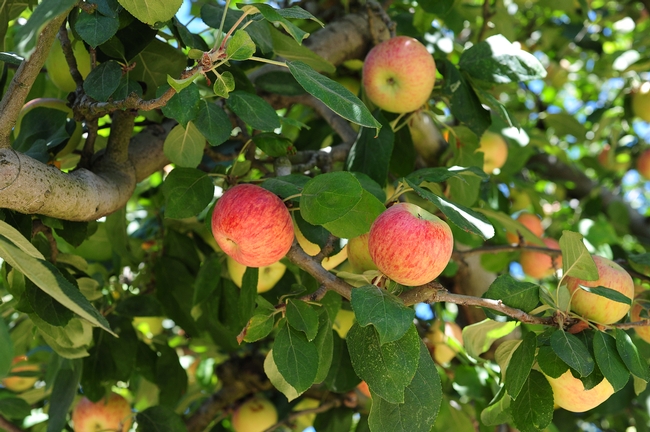
Gravenstein apples hang from a tree in Sonoma County. (Photo by Kathy Keatley Garvey)

Gravensteins are usually streaked with red, but Nature's paintbrush created this effect. (Photo by Kathy Keatley Garvey)


